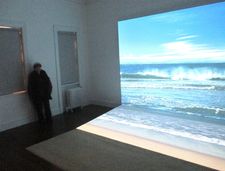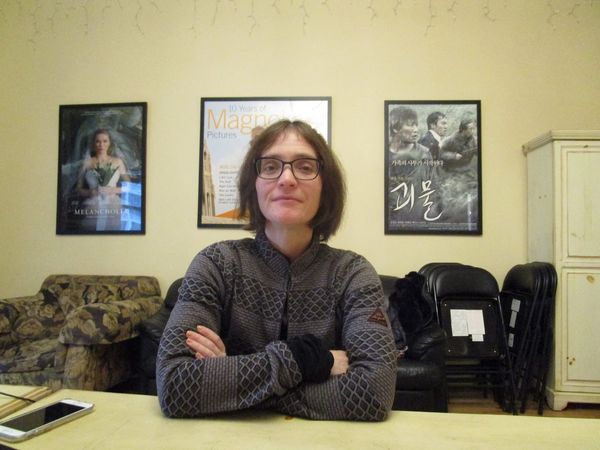 |
| Alla Kovgan at Magnolia Pictures on Cunningham composer Hauschka: “He became almost like a ceramic artist who would give a shape to the entire film.” Photo: Anne-Katrin Titze |
Alla Kovgan’s Cunningham, shot by Mko Malkhasyan with Joséphine Derobe (Wim Wenders’ Les Beaux Jours D'Aranjuez with Reda Kateb and Sophie Semin; Everything Will Be Fine; The Berlin Philharmonie in Cathedrals Of Culture; Pina and If Buildings Could Talk with Alain Derobe) as the Director of Stereography, Director of Choreography Jennifer Goggans with Supervising Director of Choreography Robert Swinston and a flawless score by Hauschka aka Volker Bertelmann (BAFTA and Oscar nominated composer with Dustin O'Halloran for Garth Davis’s Lion) takes us creatively into the world of Merce Cunningham.
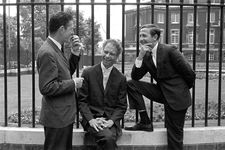 |
| John Cage with Merce Cunningham and Robert Rauschenberg Photo: Douglas Jeffrey |
In the first part of my chat with Alla Kovgan, we discussed Merce Cunningham’s collaborations with Robert Rauschenberg and Rei Kawakubo of Comme des Garçons, composers John Cage and Conlon Nancarrow, Morton Feldman and David Tudor, a quote from Viola Farber, Carolyn Brown’s memoir Chance and Circumstance: Twenty Years with Cage and Cunningham, Agnès Varda’s Bord De Mer, George Sidney’s Kiss Me Kate, working with 3D technology and Hauschka for Cunningham.
Anne-Katrin Titze: Merce Cunningham was born in 1919!
Alla Kovgan: Yes, 100 years ago.
AKT: Were you timing it that way for the film to be ready for the centennial? Is it coincidence?
AK: Pure coincidence. The idea came in 2011, nobody imagined that this project is going to take seven years to be realised.
AKT: 2011! The person [Joséphine Derobe] who was working on the 3D with you was also working on Pina. So Pina came before?
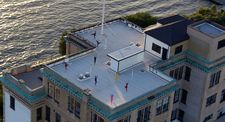 |
| Cunningham on the Westbeth roof in New York: “This was a real impulse and instinct to put the dancers there and to see them as part of that monumental thing.” Photo: Mko Malkhasyan |
AK: Right. Pina came in 2011, too. What happened when I saw it [Pina] - because I had quite a bit of interest in dance film collaborations through my entire life - I was thinking, okay, maybe something is possible between 3D and dance. Especially the Rite of Spring sequence in Wim Wenders' film was quite amazing.
I felt like 3D can work with space like no other medium of technology. That coincided with the last performance of the Merce Cunningham Dance Company. At the end of 2011 the company closed, on December 31. The Dance Films Association had a grant from the Rockefeller Foundation to create a film about New York based choreography using 3D technology.
When I saw the last performance of the company, that really struck me. Perhaps 3D and Merce can be an amazing fit. I never wanted to make a film about Merce Cunningham at first. I knew of his work, of course. I showed his work on film because I used to have a festival in St. Petersburg in Russia. But he's the kind of choreographer where he has, you know, 16 people going in different directions and you cannot frame a single shot.
AKT: Right. Very difficult to capture.
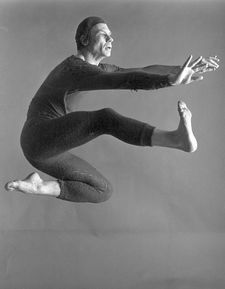 |
| Alla Kovgan on Merce Cunningham: “He works in space. Well, 3D works in space too.” Photo: Robert Rutledge |
AK: He works in space. Well, 3D works in space too. I always say, the best 3D film will have no cuts. So that was the first kind of inkling that I had.
AKT: I am thinking of early 3D films, Kiss Me Kate.
AK: Kiss Me Kate, yes of course.
AKT: One of the first dance films using 3D.
AK: Absolutely, but it's still used a lot like a gimmick.
AKT: Throwing bones at the audience?
AK: Yeah, stuff like that. It's not the conscious decision that you need to choreograph the human eye. You need to choreograph the camera. 3D is an experience.
It requires your brain to work 30% harder, because you actually have to convert your eyes. That settles you down and you also start feeling the distance between people. You're much more attentive. And you immerse yourself. This immersive thing does happen.
AKT: So it creates an event.
AK: Exactly.
AKT: You start in the tunnel and very soon we fly over the roofs of the city. A particular roof in New York.
AK: It's New York, yes, it's Westbeth.
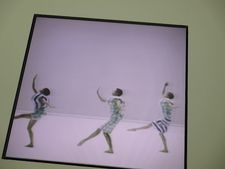 |
| Merce Cunningham - Scenario in the Rei Kawakubo/Comme des Garçons: Art of the In-Between at The Metropolitan Museum of Art’s Costume Institute Photo: Anne-Katrin Titze |
AKT: The tunnel and the tower is where you begin?
AK: Actually there's so much thought through this film. Everything is very kind of meticulously worked out. It was clear we could not make this film without New York. The film was shot in only 18 days. Two days were in France, one day was in New York, and the other 15 days were in Germany.
The last day was in New York City and it came down to the very last minute that we actually found the money to do it. The only thing we could think about was to shoot it over Westbeth because that's the place where Merce spent 40 years of his life. And of course it's next to the river; Hudson River has his ashes. It felt like super symbolic to do that there.
AKT: Hudson River has his ashes?
AK: Yes. It was an interesting feeling. Merce used that rooftop himself quite a bit. This was a real impulse and instinct to put the dancers there and to see them as part of that monumental thing. For us this film is not about capturing Merce's dances, it's about trying to translate his ideas into cinema.
All those things we did with locations was always trying to either use them as a metaphor, as a way to amplify his ideas, or situate them in some kind of narrative context. So those shots over the rooftops was that, introduction to him.
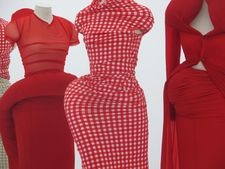 |
| Rei Kawakubo/Comme des Garçons: Art of the In-Between at The Metropolitan Museum of Art’s Costume Institute Photo: Anne-Katrin Titze |
And that's where he ended because that's where the class is. It's sort of an arc. The tunnel is all about 3D and dance. It's not really about Merce at all. It's about setting up this idea of body in space. That's all it does.
AKT: The birth canal?
AK: I didn't think about it but there's this one person with this forward motion. It's just very strong cinema and very strong dance.
AKT: I always loved Summerspace. It's so beautiful, the pointillism, the Rauschenberg "wrapping". You did a marvellous job with it, putting it in 3D.
AK: Thank you. That was a quintessential thing. Then again, it's Merce at work. He actually stages photographs himself of that in 1958 where he dropped the decor on the walls and on the floor.
AKT: I was thinking of that when Agnès Varda had one of her last exhibitions here in New York where she did something similar with an image of a beach leading into actual sand on the gallery floor.
AK: Absolutely, I remember. I have seen this. There's a kind of thing about the space, about wrapping the space, creating an environment that's not separate. Floor, walls, all that stuff. I think for Merce, he never could do that on stage.
Carolyn Brown in her book remembers how frustrated he was that he could not have this decor everywhere so he staged pictures, photographs. It's also no fixed points in space, you are able to see the dancer from all different directions.
So I said, okay, we have to imagine this giant ball that's covered with that decor and you were inside with him. Now with technology we can actually do that. We went to Walker Art Center, we took 320 pictures of the original, we stitched them together, we made a digital version we printed on the floor and the costumes and then shot green screen and then wrapped it.
AKT: We hear that Merce taught himself to knit.
AK: John Cage says that Merce taught himself to knit.
AKT: The knitting fits with what you said.
AK: The threads, absolutely. Doing things. The amazing thing about Merce is that he was a doer and he said yes to things. Which I think we have to all learn today.
AKT: Rei Kawakubo of Comme des Garçons made some of the costumes for Cunningham.
AK: That was a later period, yeah.
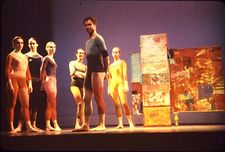 |
| Merce Cunningham Dance Company with a Robert Rauschenberg set Photo: John Ross |
AKT: Did you see the exhibition at The Met?
AK: Yes, amazing. But the question for the costumes, most of this period falls on Rauschenberg. This is this period of Merce's collaboration with Robert Rauschenberg. They made 16 collaborations out of the 22. In those ten years between '53 and '64 basically. This was an incredible meeting of the minds.
And Rauschenberg, unlike any other artist they worked with later, was a real company designer, which is different from just being a visual artist doing your own thing. He travelled with them, he was part of this whole community.
AKT: Merce's collaborations with artists from all walks of life were amazing.
AK: Everybody was attracted to him. He was also giving a lot of freedom to people. This process he set up - collaboration without collaborating. He trusts you, so go and work! So that's all you have to do. And then if you do that, it'll work out. Or maybe even if you're good, it may not work out. He is willing to accept that.
AKT: It's where the element of surprise and chance comes in.
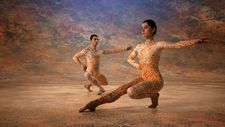 |
| Alla Kovgan on Summerspace in 3D: “There's a kind of thing about the space, about wrapping the space, creating an environment that's not separate. Floor, walls, all that stuff.” Photo: Mko Malkhasyan |
AK: And the risk. Because it may not work, and you're okay with that. Now we can't do this anymore. The environment changed too much. They were able to do that. They were able to accept a failure or they didn't treat it as a failure. It was part of the process.
AKT: "He is interested in our flaws", a dancer says.
AK: Viola Farber. Yes, absolutely.
AKT: Now every "failure" once captured is out there to possibly haunt you forever.
AK: Now you have to succeed. Everything has to be like, if you don't succeed, you have no chance. That's the tragedy of our existence.
AKT: You also have some very interesting collaborators on this film. For the music, you worked with Hauschka.
AK: Do you know Hauschka?
AKT: Not personally. From his work on Lion, where he was one of the co-composers.
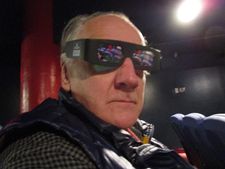 |
| Ed Bahlman wearing 3D glasses for the Cunningham press screening at Film Forum Photo: Anne-Katrin Titze |
AK: Hauschka is very interesting because he's a guru of prepared piano. But he invented his own way of dealing with prepared piano and then he learned about John Cage, which is so interesting. He's very diverse. He can write anything really, from rock music to this incredibly contemporary modern music. I felt like that I needed someone who is open.
Also he is kind of entering in this world of all these names like John Cage and Ned Rorem, Morton Feldman and David Tudor. He was incredibly open. It's a difficult film, because there's just so many different music tonalities and tones. He basically came in with a kind of through-line which we wanted to establish. He became almost like a ceramic artist who would give a shape to the entire film.
- Cunningham is currently streaming on Curzon Home Cinema in the UK
- Read part two of our conversation with Alla Kovgan
- Read our conversation with Rashaun Mitchell and Silas Riener








